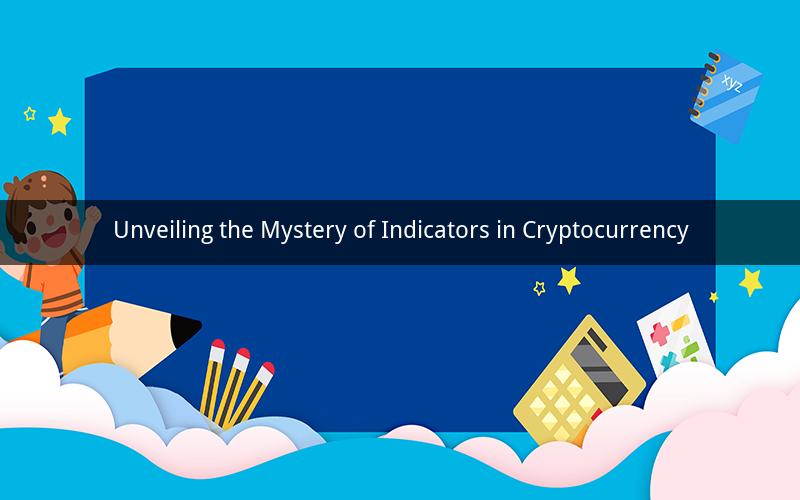
In the rapidly evolving world of cryptocurrency, indicators play a crucial role in helping investors make informed decisions. But what exactly is an indicator in the context of digital currencies? This article delves into the concept of indicators, their significance, and how they can be utilized to analyze the cryptocurrency market.
What is an Indicator in Cryptocurrency?
An indicator in cryptocurrency refers to a statistical measure or value used to analyze market data and predict future price movements. These indicators are derived from mathematical algorithms and are designed to provide insights into the current state of the market, identify trends, and help traders make informed decisions. Indicators can be categorized into various types, including momentum, volatility, volume, and price-based indicators.
Momentum Indicators
Momentum indicators measure the speed and direction of price movements. They are primarily used to identify overbought or oversold conditions in the market. Some commonly used momentum indicators in cryptocurrency include:
1. Relative Strength Index (RSI): RSI compares the magnitude of recent gains to recent losses to determine overbought or oversold conditions. A reading above 70 indicates an overbought condition, while a reading below 30 suggests an oversold condition.
2. Moving Average Convergence Divergence (MACD): MACD is a trend-following momentum indicator that shows the relationship between two moving averages of an asset's price. It helps identify buy and sell signals based on the convergence and divergence of these averages.
Volatility Indicators
Volatility indicators are used to measure the degree of variation in the price of a cryptocurrency. They help traders understand the market's stability and predict potential price swings. Some popular volatility indicators include:
1. Average True Range (ATR): ATR measures the average true range of an asset's price over a specified period. It is used to identify the volatility level and potential price swings.
2. Bollinger Bands: Bollinger Bands consist of a middle band being an N-period simple moving average (SMA) and two outer bands that are standard deviations away from the middle band. The bands help identify overbought or oversold conditions and potential price reversals.
Volume Indicators
Volume indicators provide insights into the trading activity of a cryptocurrency. They help traders determine the strength of a price move and identify potential market trends. Some commonly used volume indicators include:
1. On-Balance Volume (OBV): OBV is a momentum indicator that measures the cumulative volume flow of a security. It helps identify buy and sell signals based on the relationship between price and volume.
2. Accumulation/Distribution Index (ADI): ADI measures the accumulation and distribution of a cryptocurrency's price. It helps traders identify whether a cryptocurrency is being accumulated or distributed by investors.
Price-Based Indicators
Price-based indicators are used to analyze the price movements of a cryptocurrency. They help traders identify patterns and trends in the market. Some popular price-based indicators include:
1. Fibonacci Retracement: Fibonacci retracement is a tool used to identify potential support and resistance levels in the market. It is based on Fibonacci numbers, which are used to identify retracement levels after a significant price move.
2. Moving Averages: Moving averages are used to smooth out price data and identify trends. They help traders determine the overall direction of the market and identify potential entry and exit points.
How to Utilize Indicators in Cryptocurrency Trading
Now that we understand the different types of indicators, let's explore how to utilize them in cryptocurrency trading:
1. Combine Indicators: It is essential to combine different indicators to gain a comprehensive understanding of the market. For instance, combining RSI and MACD can provide a more accurate buy and sell signal.
2. Time Frame: Use indicators on different time frames to identify long-term and short-term trends. This helps traders make informed decisions based on the market's overall direction.
3. Backtesting: Before implementing an indicator in live trading, it is crucial to backtest it on historical data. This ensures that the indicator works effectively and provides reliable signals.
4. Risk Management: Utilize indicators in conjunction with risk management strategies to minimize potential losses. For instance, setting stop-loss orders based on indicators can help protect your investment.
5. Continuous Learning: The cryptocurrency market is highly dynamic, and indicators may not always be accurate. It is essential to continuously learn and adapt your trading strategy based on market conditions.
In conclusion, indicators are essential tools for analyzing the cryptocurrency market and making informed trading decisions. By understanding the different types of indicators and how to utilize them effectively, traders can improve their chances of success in the volatile world of digital currencies.
Questions and Answers:
1. What is the primary purpose of momentum indicators in cryptocurrency trading?
Answer: The primary purpose of momentum indicators in cryptocurrency trading is to measure the speed and direction of price movements, helping traders identify overbought or oversold conditions and make informed trading decisions.
2. How can volatility indicators help traders in the cryptocurrency market?
Answer: Volatility indicators help traders understand the market's stability and predict potential price swings. By identifying high volatility levels, traders can adjust their strategies accordingly and minimize potential losses.
3. What is the difference between RSI and MACD?
Answer: RSI compares the magnitude of recent gains to recent losses, while MACD shows the relationship between two moving averages of an asset's price. RSI is more suitable for identifying overbought or oversold conditions, while MACD is a trend-following indicator that helps identify buy and sell signals.
4. How can volume indicators help traders in the cryptocurrency market?
Answer: Volume indicators provide insights into the trading activity of a cryptocurrency, helping traders determine the strength of a price move and identify potential market trends.
5. What is the importance of backtesting indicators before implementing them in live trading?
Answer: Backtesting indicators on historical data helps ensure their effectiveness and reliability. It allows traders to understand how the indicators would have performed in the past and make informed decisions based on their performance.